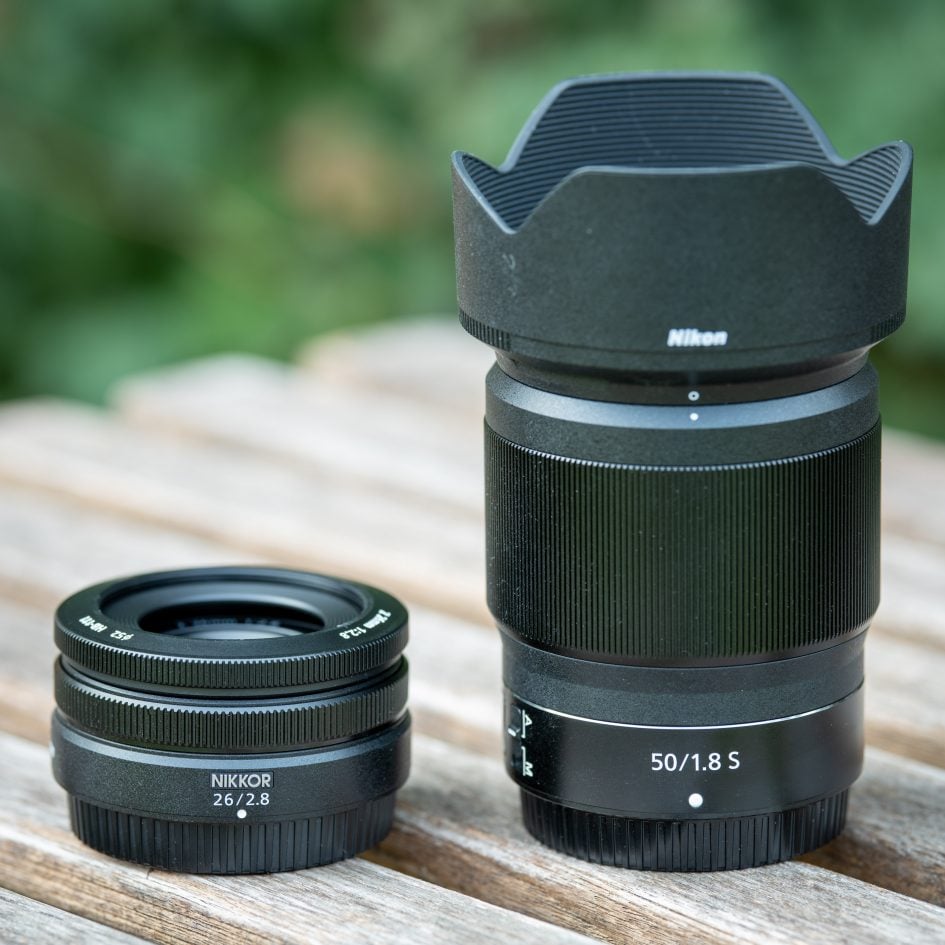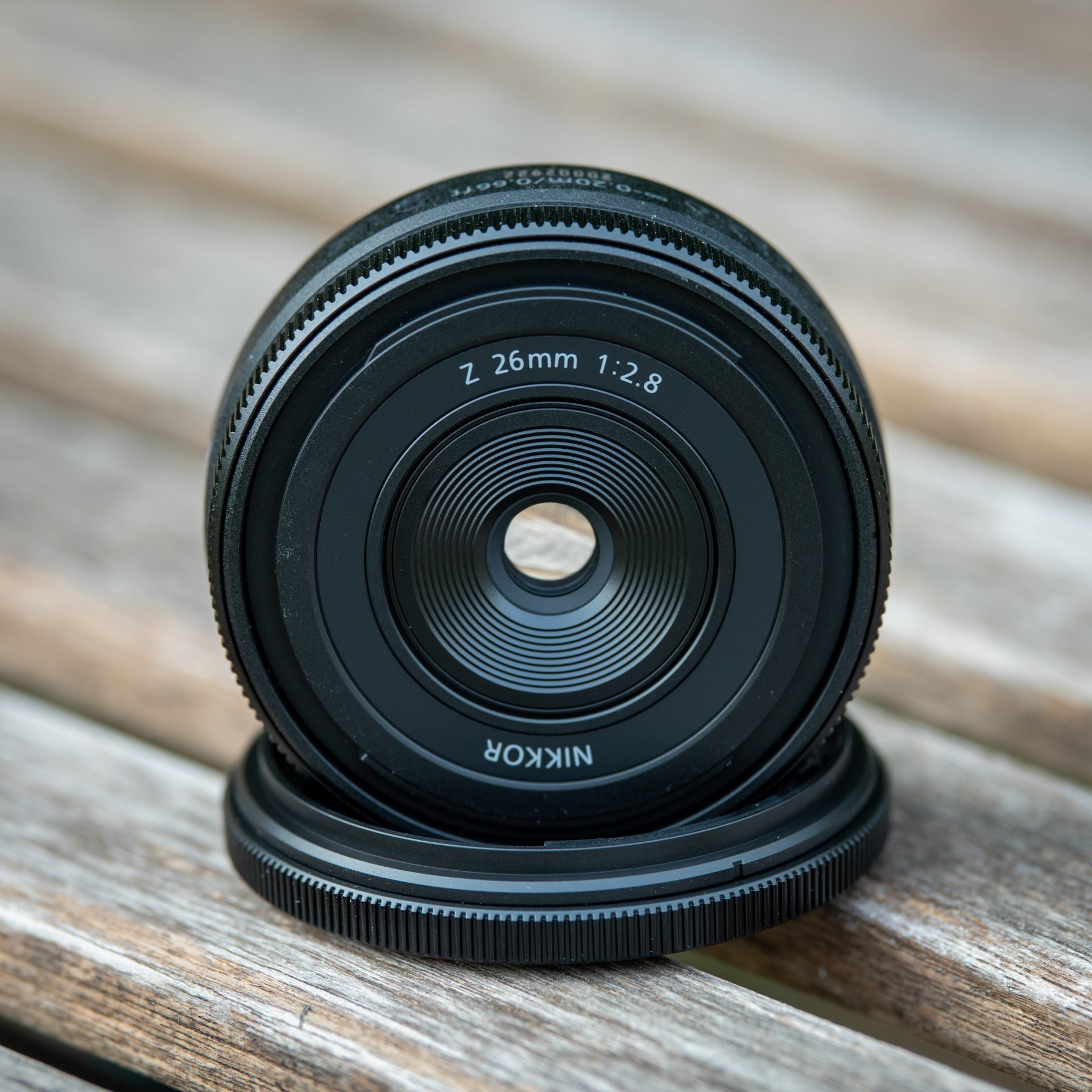Nikon Z 26mm f2.8 review
-
-
Written by Thomas
Verdict
The Nikon Z 26mm f2.8 is a very small wide-angle lens corrected for full-frame sensors. It’s even smaller and lighter than the diminutive Z 28mm f2.8 – or any mirrorless full-frame AF lens from Sony or Canon. Its optical performance is very good up to 8mm image height but outside this image circle the lens suffers from coma and clearly benefits from stopping down to f4.0 – or even f5.6 if you’re looking into the FX-corners. Stopping down also reduces the very strong light fall-off which is over -2 EV even after the lens profile is applied. Focus is fast and very reliable but produces visible focus breathing and is quite noisy. There’s also a bit of focus shift but this should not be a problem if you re-focus after changing the aperture. Bokeh is meagre (as is to be expected from a 26mm f2.8 lens) but still manages a smooth transition towards the background and shows very little color artifacts as longitudinal color aberrations of the lens are well controlled.
Let’s put this into perspective and have a closer look at how the Nikon Z 26mm f2.8 compares to Nikon’s 24mm and 28mm primes and their 24-50mm zoom lens.
Above: Nikon Z 26mm f2.8 (left), Nikon Z 50mm f1.8 S (right), both with lens hood
Compared to Nikon Z 28mm f2.8
The Z 28mm f2.8 produces a field of view which is 7% narrower than from the Z 26mm f2.8. So, to get the same framing for e.g. a full body shot you’d have to step back around 0.5m from 5.9m to 6.4m. This does not seem much but it may not be possible in close quarters. Looking at the difference in focal lengths the other way around: If you shoot with the 26mm lens you’d need to crop from e.g. 45MP to 39MP to achieve the same framing as with the 28mm lens – not a huge loss of pixels. And as the Z 26mm f2.8 is sharper than the Z 28mm f2.8 the lens easily makes up for that loss. With other optical qualities like Bokeh or resistance against flare and glare pretty similar the major differences between both lenses lie in price, size, and weight: The Nikon Z 28mm f2.8 is a small lens but certainly not as small and light-weight as the “pancake” Z 26mm f2.8. But at a price which is only half of the 26mm lens it is certainly a compelling alternative if your budget is limited.
For more details see my Nikon Z 28mm f2.8 review where the lens earned a Recommended.
Compared to Nikon Z 24mm f1.8 S
The major difference between the new Z 26mm f2.8 and Nikon’s S-line wide-angle 24mm lens is a 1.3 stop brighter focal ratio. This lets you shoot the S-line lenses at shorter shutter-speeds or lower ISO and allows for a stronger Bokeh. But hand-in-hand with the brighter focal ratio and more complex optical design of the Z 24mm f1.8 S go the other differences which sets it apart from the Z 26mm f2.8: It is almost 4 times as long (with lens hood), 3.5 times heavier, and around two times as expensive. And as optical performance of the S-line lens is not that much better the decisive differences between both lenses is price, size, and weight – which favors the pancake Z 26mm f2.8 – and focal ratio (resulting in better light gathering and smoother Bokeh) – which favors the Z 24mm f1.8 S.
For more details see my Nikon Z 24mm f1.8 S review where the lens earned a Highly Recommended.
Compared to Nikon Z 24-50mm f4-6.3
You wouldn’t expect a zoom lens to come up as an alternative for a prime lens, wouldn’t you? Well, the Z 24-50mm f4-5.6 is a very interesting alternative: optically it is as good as the Z 26mm f2.8, its price is in the same ball park and it also is not a huge and heavy lens. In the end it comes down to whether you favor the flexibility of a zoom lens or want the brighter focal ratio of the Z 26mm f2.8 with its smoother Bokeh.
For more details see my Nikon Z 24-50mm f4-6.3 review where the lens earned a Recommended.
Nikon Z 26mm f2.8 final verdict
Nikon’s Z 26mm f2.8 is the smallest and lightest autofocus lens for Z-mount to date. It is corrected for full-frame sensors and produces very sharp images in the center at any object distance even wide open. But for satisfying corner sharpness you need to stop down a bit – which also helps reduce the very strong vignetting. Another quirk is the noisy focus drive. But if you want the smallest and lightest I can fully recommend this lens. Still, consider the Z 28mm f2.8 as a slightly larger and heavier alternative – at half the price.
Good points:
- The smallest and lightest lens with autofocus for Z-mount.
- Very good resolution in the center at any object distances.
- Very little longitudinal colour aberrations.
- Weather sealing, multi-function ring.
Bad points:
- Focus noise.
- Strong coma and vignetting.
- Focus shift.
- Needs stopping down to f4.0 for better contrast and resolution outside the center.
- Short working distance for close-up shots.
- Meagre Bokeh.






